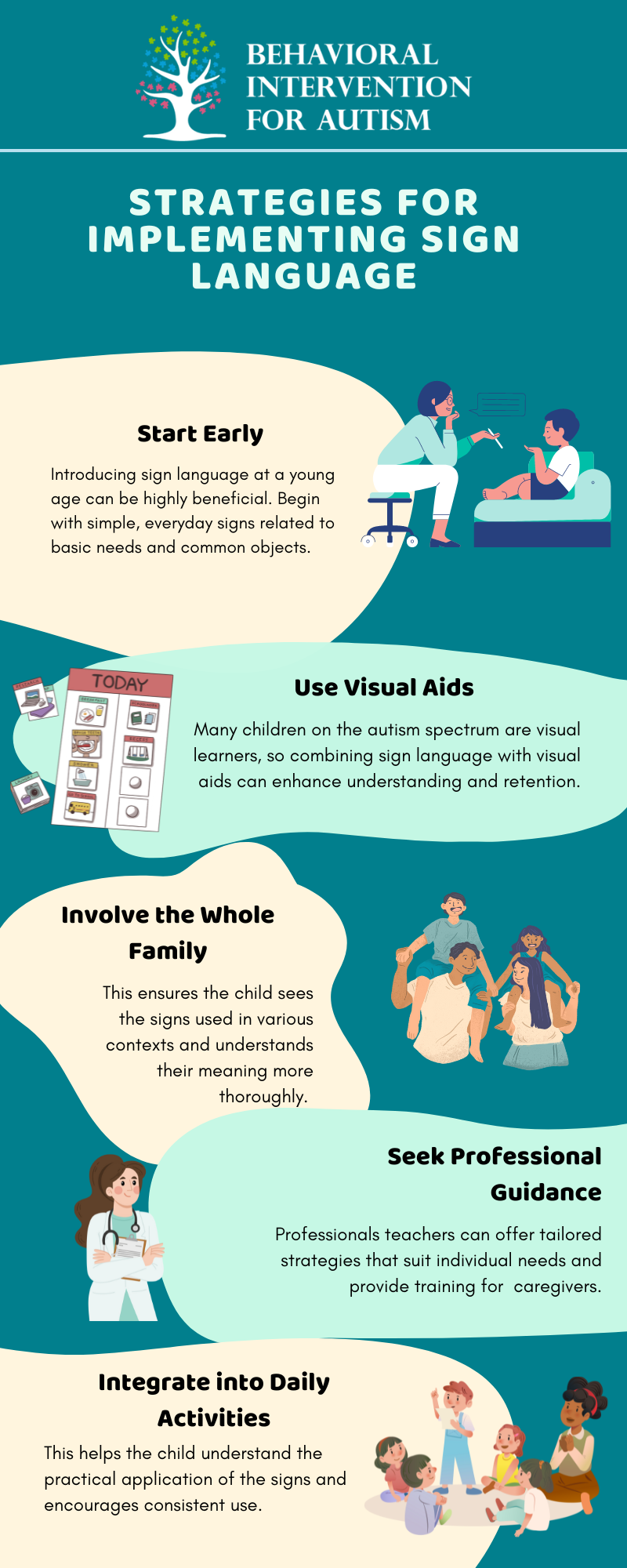
Table of Contents
Sign language, a rich and versatile linguistic structure with its own grammar, is not just for the deaf and hearing-impaired. It also offers significant benefits for autistic individuals. For parents and caregivers of autistic children, understanding the advantages and strategies for using sign language can be transformative in enhancing communication and reducing frustration.
The Benefits of Sign Language for Autistic Individuals
Understanding the benefits of sign language for autistic individuals can significantly improve their ability to communicate and interact with the world around them. In this section, we will explore the various ways sign language can foster a more positive environment for autistic individuals and their families.
Enhanced Communication
Autistic individuals often face challenges in verbal communication, which can lead to frustration and behavioral issues. Sign language provides a visual and kinesthetic means of communication that can bridge the gap. Many autistic children respond better to visual stimuli than auditory ones, making sign language a particularly effective tool.
Early Language Development
Introducing sign language early can support language development. Contrary to common fears, using sign language does not hinder verbal language development. In fact, it can facilitate it. Children who learn to sign often transition more smoothly into verbal communication, as sign language helps them develop the fundamental skills of language and expression.
Reduced Frustration and Behavioral Issues
Being unable to communicate needs and desires can lead to significant frustration for autistic children. Sign language offers an immediate way for these children to express themselves, which can reduce the incidence of frustration-induced behaviors. This can create a more positive and calm environment for both the child and their caregivers.
Strategies for Implementing Sign Language
Implementing sign language as a communication tool for autistic children can seem daunting, but with the right strategies, it becomes a manageable and rewarding process. This section provides practical tips to effectively introduce sign language in daily life. By following these strategies, you can create a significant difference in your child’s ability to express themselves.
Start Early
Introducing sign language at a young age can be highly beneficial. Begin with simple, everyday signs related to basic needs and common objects. Consistency and repetition are key to helping the child learn and remember the signs.
Use Visual Aids
Visual aids such as picture cards and videos can reinforce the learning of signs. Many children on the autism spectrum are visual learners, so combining sign language with visual aids can enhance understanding and retention.
Involve the Whole Family
For sign language to be effective, it’s important that the whole family participates. This ensures the child sees the signs used in various contexts and understands their meaning more thoroughly. Family involvement also supports the child emotionally and socially.
Seek Professional Guidance
Speech therapists and special education teachers can provide valuable guidance and support in teaching sign language. They can offer tailored strategies that suit the individual needs of the autistic child and provide training for parents and caregivers.
Integrate into Daily Activities
Incorporate sign language into daily routines and activities. Use signs during meals, playtime, and other regular interactions. This helps the child understand the practical application of the signs and encourages consistent use.
Overcoming Common Concerns
While the benefits of sign language for autistic individuals are clear, parents and caregivers often have understandable concerns about its implementation. In this section, we will dispel common myths and provide practical solutions to help you confidently incorporate sign language into your child’s routine and ensure effective adoption of it.
Will Sign Language Delay Verbal Speech?
A common worry among parents is that using sign language might hinder their child’s verbal speech development. However, research indicates that this is not the case. The study found that using sign language in conjunction with speech therapy can stimulate language development.
While completely nonverbal children might not gain spoken words through this method, sign language can still serve as a vital communication tool. Nonverbal individuals can lead fulfilling lives by effectively expressing themselves through sign language.
How to Stay Consistent?
It’s important to integrate sign language into daily routines and ensure that all caregivers and family members use the same signs. Set specific times each day for practice, such as during meals, playtime, or bedtime routines.
Using visual aids like picture cards and videos can also reinforce learning. Collaborating with speech therapists and special education teachers can provide additional support and tailored strategies to maintain consistency.
Is Sign Language Suitable for All Autistic Children?
While sign language has many benefits, it may not be suitable for every autistic child. Here are some considerations:
- Motor Skills: Signing involves the careful use of hands and arms. Children who struggle with fine motor skills might find signing challenging. In such cases, other Augmentative and Alternative Communication (AAC) methods, like picture exchange communication systems (PECs) or flashcards, might be more appropriate.
- Facial Expressions and Eye Contact: American Sign Language (ASL) often uses facial expressions to convey nuanced meanings, and eye contact is a common part of ASL etiquette. Children who have difficulty interpreting facial expressions or who are uncomfortable with eye contact may find this aspect of ASL challenging. It’s important to adapt communication strategies to suit the child’s comfort and abilities.
- Stimming: Self-stimulatory behaviors, or stimming, are common in autistic individuals and can involve hand movements that might interfere with signing. This is not inherently negative but could cause confusion or distraction during conversations. Finding a balance and incorporating other communication aids might be necessary.
What If Sign Language Becomes the Primary Communication Method?
For some autistic children, sign language might become the primary communication method. This is acceptable and can still lead to a fulfilling life. The goal is to ensure that the child can express their needs, thoughts, and feelings effectively, regardless of communication method.
Where to Learn Sign Language?
There are numerous resources available for learning sign language, including online courses, apps, books, and local classes. Engaging with these resources can provide a structured approach to learning and ensure correct sign usage.
Conclusion
Sign language is a powerful tool for improving communication in autistic individuals. It supports early language development, reduces frustration, and can enhance the overall quality of life. By starting early, involving the whole family, using visual aids, and seeking professional guidance, parents and caregivers can successfully integrate sign language into daily routines.
Sources:
- https://www.msjonline.org/index.php/ijrms/article/view/11562
- https://www.handtalk.me/en/blog/sign-language-communication/
- https://www.autismparentingmagazine.com/autistic-child-sign-language/
- 9 Common Obsessions of Children With Autism You Should Know - February 25, 2025
- What is Neurodiversity? A Guide to Embracing Differences - February 25, 2025
- Understanding Hyperfocus in Autism: What It Means and Why It Happens - February 25, 2025



